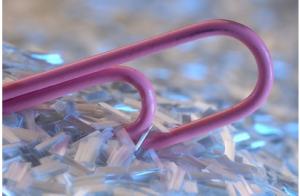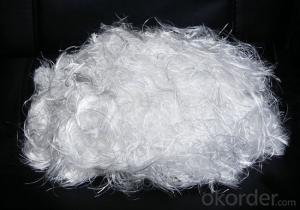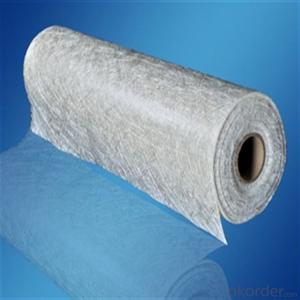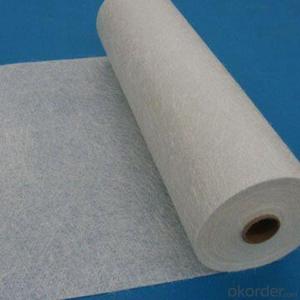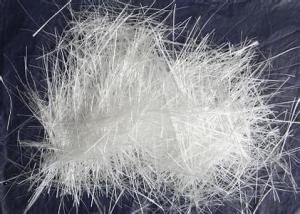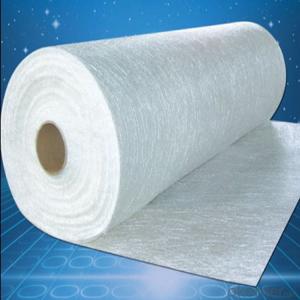E Glass Fiber Chopped Strands For Thermoplastic
- Loading Port:
- Shanghai
- Payment Terms:
- TT or LC
- Min Order Qty:
- 20000 kg
- Supply Capability:
- 200000 kg/month
OKorder Service Pledge
OKorder Financial Service
You Might Also Like
Description:
Chopped Stands for Thermoplastic are based on silane coupling agent and special sizing formulation, compatible with PA,PBT/PET, PP, AS/ABS, PC, PPS/PPO,POM, LCP;
E-Glass Chopped Stands for thermoplastic are know for excellent strand integrity, superior flowability and processing property, delivering excellent mechanical property and high surface quality to its finished product.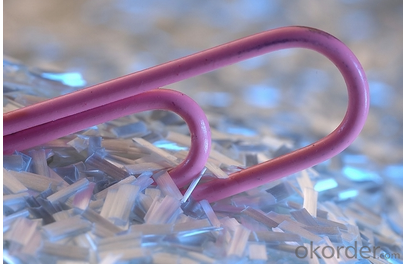
Product Features:
● Extremely low resin demand, delivering low viscosity to BMC paste
● High impact strength; High LOI rate
● High strand stiffness; Compatible with rubber
Product Specifications:
Property | Fibre diameter | Moisture Content | Size Content | Chop |
(%) | (%) | (%) | (%) | |
Mathods | IS01888 | ISO3344 | ISO1887 | |
3mm | ±10 | ≤3.0 | 0.1±0.05 | 98 |
6mm | ||||
9mm | ||||
12mm |
● Special specification can be produce according to customer requirements.
Packaging:
Each bag can be taken (15-25kgs)。 Could also take a big container bag.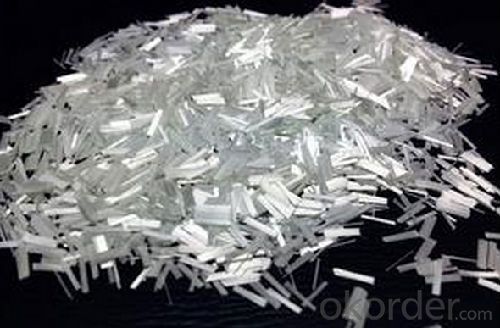
Storage:
Unless otherwise specified, It should be stored in a dry, cool and rain-proof area. It is recommended that the room temperature and humidity should be always maintained at 15℃~35℃ and 35%~65% respectively.
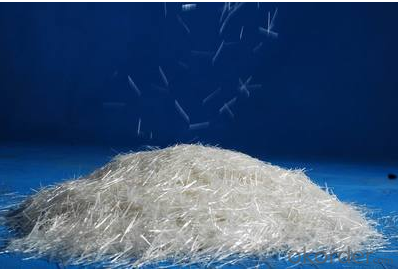
FAQ:
1.Who will pay for the express cost ?
A: We can support you free samples ,but express cost will be paid by you .
2.How long is the delivery time?
A:within 10-15 days after receiving depos
- Q:What are the impact strength properties of fiberglass chopped strand?
- The impact strength of fiberglass chopped strand is impressive, providing exceptional resistance to both impact and stress. This is primarily because the fiberglass material itself possesses inherent strength and rigidity. The chopped strands, consisting of short pieces of glass fibers randomly arranged and held together by a resin matrix, contribute to the material's ability to withstand high impact forces without breaking or fracturing. Due to its outstanding impact strength properties, fiberglass chopped strand is highly suitable for applications where impact resistance is of utmost importance. It is widely used in the manufacturing of various products, including automotive parts, boat hulls, sporting equipment, and construction materials. In these applications, the material effectively absorbs and disperses impact forces, minimizing the risk of damage or failure. Moreover, by incorporating other reinforcing materials or additives, fiberglass chopped strand can offer even greater impact resistance. For instance, the addition of fillers or modifiers to the resin matrix can further enhance the material's impact strength properties. This flexibility allows for customization and optimization of the material's performance to meet specific application requirements. To summarize, fiberglass chopped strand exhibits remarkable impact strength properties, making it a durable and trustworthy material. Its ability to withstand impact forces without breaking or fracturing renders it suitable for a wide range of applications where impact resistance is vital.
- Q:How does the fiber diameter affect the performance of fiberglass chopped strand?
- The fiber diameter plays a crucial role in determining the performance of fiberglass chopped strand. The diameter directly influences the mechanical properties, such as strength, stiffness, and impact resistance, of the chopped strand. A smaller fiber diameter generally leads to higher strength and stiffness. This is because a smaller diameter allows for a larger number of fibers to be incorporated into a given volume, resulting in more efficient load transfer and increased overall strength. Additionally, smaller diameter fibers tend to have fewer defects, such as voids or impurities, which can weaken the material. Moreover, a smaller diameter also enhances the interfacial bonding between the fibers and the matrix material, improving the overall composite performance. The increased surface area of the smaller fibers allows for better adhesion with the matrix, resulting in improved load transfer and enhanced mechanical properties. However, it is important to note that there is an optimal fiber diameter range for specific applications. If the fiber diameter becomes too small, it may become difficult to handle and process, leading to challenges in achieving uniform distribution and effective reinforcement within the matrix. On the other hand, if the fiber diameter becomes too large, it may result in a less efficient use of the material and reduced mechanical properties. In summary, the fiber diameter of fiberglass chopped strand significantly affects its performance. A smaller diameter generally improves strength, stiffness, and interfacial bonding, while also reducing defects. However, there is an optimal range to consider for each application to ensure ease of processing and optimal reinforcement.
- Q:Is fiberglass chopped strand suitable for renewable energy applications?
- Yes, fiberglass chopped strand is suitable for renewable energy applications. Fiberglass is a versatile material known for its strength, durability, and resistance to corrosion, making it an ideal choice for various renewable energy applications. In wind energy, fiberglass chopped strand is commonly used in the manufacturing of wind turbine blades. The material's high tensile strength and ability to withstand harsh weather conditions make it an excellent choice for this application. Fiberglass also offers lightweight properties, which is crucial for minimizing the weight of the blades and maximizing energy production. Furthermore, fiberglass chopped strand is used in the construction of solar panels. The material provides excellent electrical insulation, which is essential for maintaining the efficiency and safety of solar panels. Fiberglass also offers high thermal resistance, enabling the panels to withstand extreme temperatures and prolong their lifespan. Additionally, fiberglass chopped strand can be used in the manufacturing of hydroelectric power equipment. Its corrosion resistance properties make it suitable for withstanding the harsh conditions present in hydroelectric power plants, such as exposure to water and moisture. Overall, fiberglass chopped strand is a reliable and effective material for renewable energy applications. Its strength, durability, and resistance properties make it a suitable choice for wind energy, solar power, and hydroelectric power applications.
- Q:What are the environmental impacts of using fiberglass chopped strand?
- The utilization of fiberglass chopped strand can yield both positive and negative consequences for the environment. On the positive side, fiberglass proves to be an extremely durable substance that finds utility in a range of applications, including construction and manufacturing. Its high strength-to-weight ratio makes it an efficient alternative to other materials, resulting in reduced material requirements overall and potentially lowering energy consumption during production and transportation. Nevertheless, the creation and disposal of fiberglass chopped strand also inflict several adverse effects on the environment. Firstly, the manufacturing process necessitates the extraction and processing of raw materials such as silica sand, limestone, and soda ash. These procedures demand significant amounts of energy and can contribute to air and water pollution, as well as the destruction of habitats in the areas where these materials are sourced. Moreover, the production of fiberglass entails the use of chemicals, like resins and binders, which, if not handled properly, can pose risks to both human health and the environment. The release of these chemicals during manufacturing or disposal can contaminate the air, water, and soil, detrimentally impacting ecosystems and potentially causing health hazards for humans and wildlife alike. Furthermore, fiberglass is non-biodegradable, meaning that once it reaches the end of its useful life, it can contribute to landfill waste or require energy-intensive recycling processes. Inadequate disposal of fiberglass can result in environmental pollution and the long-term accumulation of non-biodegradable waste. To counteract these environmental impacts, it is crucial to incorporate sustainable practices throughout the life cycle of fiberglass chopped strand. This may include the use of recycled or eco-friendly materials in production, the implementation of proper waste management and recycling programs, and the adoption of energy-efficient manufacturing processes. Additionally, it is of utmost importance to handle and dispose of fiberglass waste correctly to prevent its release into the environment. In conclusion, while fiberglass chopped strand offers certain benefits, it is imperative to consider and address its environmental impacts in order to ensure a more sustainable and responsible use of this material.
- Q:How does the flexural strength of the chopped strand affect its performance?
- The flexural strength of a chopped strand plays a crucial role in determining its overall performance. Flexural strength refers to the ability of a material to resist deformation under bending or flexing forces. A higher flexural strength indicates that the chopped strand is more resistant to bending and flexing, making it more durable and less likely to break or deform under load. This is especially important in applications where the chopped strand is subjected to bending or flexing forces, such as in the construction of composite materials or reinforced concrete. The flexural strength of a chopped strand also affects its ability to transfer and distribute stress or load across a structure. A higher flexural strength allows the chopped strand to effectively distribute the applied load, reducing the risk of localized stress concentrations and potential failure. Moreover, the flexural strength of the chopped strand directly influences its mechanical properties, including stiffness and toughness. A higher flexural strength translates to a stiffer and tougher material, which can provide better structural integrity and resistance to external forces. In summary, the flexural strength of a chopped strand significantly impacts its performance. A higher flexural strength results in improved durability, load-bearing capacity, and structural integrity, making it a desirable choice in various applications where bending or flexing forces are present.
- Q:Can fiberglass chopped strand be used for reinforcing ceramic matrix composites?
- No, fiberglass chopped strand cannot be used for reinforcing ceramic matrix composites. Ceramic matrix composites usually require high-temperature resistant materials for reinforcement, as they are designed to withstand extreme heat and provide excellent mechanical properties at elevated temperatures. Fiberglass, on the other hand, may not have the necessary thermal stability to withstand the high temperatures required for ceramic matrix composites. Additionally, the thermal expansion coefficients of fiberglass and ceramics are usually significantly different, which can lead to poor compatibility and potential failure of the composite. Therefore, alternative high-temperature resistant fibers, such as carbon fibers or silicon carbide fibers, are typically used for reinforcing ceramic matrix composites.
- Q:What is the difference between the ferte and shortcoming of the carbon fiber?
- Basically it does not increase the component section, and the increase of the self weight of structures can be ignored, which can ensure it can work with the original reinforced concrete members together and get good reinforcing effect. It is widely used in building structure reinforcement. 2 convenient construction: It boasts less occupied site, no need of large machines, no construction, no fire, no fixed site facilities, high construction efficiency. 3 high durability: It does not rust, and is very suitable for using in high acid, alkali, salt and corrosion environment. Also it has the ferte of high anti fatigue strength, wear resistance, anti-aging, etc.. The characteristics of carbon fiber composite material is a lightweight and high-strength, but processing is difficult. There are great differences among the carbon fiber production which adapt difernent technology, so as to the differences between different trade marks. But it certainly is in terms of strength, toughness and corrosion resistance are higher than the Aluminum Alloy steel and carbon fiber products. Once the damage is hard to repair, such as a piece of carbon fiber composite plate cracking, it must be replaced by a whole plate, but it can not be repaired by welding and other ordinary methods.
- Q:Is fiberglass chopped strand resistant to extreme weather conditions?
- Yes, fiberglass chopped strand is generally resistant to extreme weather conditions. It has excellent resistance to both high and low temperatures, as well as UV radiation, making it suitable for outdoor applications that are exposed to harsh weather conditions.
- Q:Can fiberglass chopped strand be used in renewable energy applications?
- Fiberglass chopped strand is indeed applicable in renewable energy sectors. It is a robust and lightweight substance extensively employed in constructing wind turbine blades. These blades must endure high wind velocities while remaining durable and impervious to corrosion. By incorporating fiberglass chopped strand into the manufacturing process, the composite material gains added strength and rigidity. Moreover, this material proves advantageous in reinforcing solar panels due to its mechanical attributes and resistance against deterioration. In summary, fiberglass chopped strand is a versatile substance that enhances the efficiency and lifespan of renewable energy machinery, thereby promoting the progression of sustainable energy sources.
- Q:Can fiberglass chopped strand be used in water treatment applications?
- Yes, fiberglass chopped strand can be used in water treatment applications. Fiberglass is a versatile material that offers excellent resistance to corrosion and chemicals, making it suitable for use in water treatment processes. Chopped strands of fiberglass can be used to reinforce various components such as pipes, tanks, and filters used in water treatment systems. The high strength and durability of fiberglass make it ideal for withstanding the harsh conditions often found in water treatment facilities. Additionally, fiberglass is non-toxic and does not leach harmful substances into the water, ensuring the safety of the treated water.
1. Manufacturer Overview |
|
|---|---|
| Location | |
| Year Established | |
| Annual Output Value | |
| Main Markets | |
| Company Certifications | |
2. Manufacturer Certificates |
|
|---|---|
| a) Certification Name | |
| Range | |
| Reference | |
| Validity Period | |
3. Manufacturer Capability |
|
|---|---|
| a)Trade Capacity | |
| Nearest Port | |
| Export Percentage | |
| No.of Employees in Trade Department | |
| Language Spoken: | |
| b)Factory Information | |
| Factory Size: | |
| No. of Production Lines | |
| Contract Manufacturing | |
| Product Price Range | |
Send your message to us
E Glass Fiber Chopped Strands For Thermoplastic
- Loading Port:
- Shanghai
- Payment Terms:
- TT or LC
- Min Order Qty:
- 20000 kg
- Supply Capability:
- 200000 kg/month
OKorder Service Pledge
OKorder Financial Service
Similar products
New products
Hot products
Hot Searches
Related keywords
